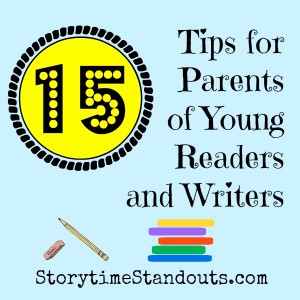15 Tips for Parents and Homeschoolers of Young Readers and Writers
Raising a child who reads well and loves to pick up a book is a team effort. Parents can support young readers’ and writers’ formal learning by being involved and enthusiastic, providing encouragement and tools.
Here are some ways you can help set the stage for reading success.
Download a free, printable PDF of this information
 15 Tips for Supporting Young Readers and Writers
15 Tips for Supporting Young Readers and Writers
Storytime Standouts shares tips for parents who want to help children with reading and writing.
• Be a reader and a writer – make sure your children see you reading books for pleasure and information as well as writing letters or making lists.
•Read aloud to your children every day – even once they have learned how to read. Make it a priority to find great articles and engaging books to share with your family.
• Be flexible. Read when, where and how it suits your child. If your child won’t sit still, it is okay to play quietly or color a picture while listening.
• Write silly notes to your children. Print out riddles and add them to a lunch bag or hide them under a pillow.
• Have Grandma or Grandpa send emails, encourage your child to reply.
• Try a new recipe, read a map, solve a mystery, check out the comics or learn magic tricks together. Help your child realize the value of being a good reader.
• Hook your child with wonderful series books or look for more books by a favourite author or illustrator.
• Encourage your child to notice and read environmental print (stop signs, entrance, exit, push and pull signs as well as labels on groceries or names of familiar stores).
• Listen to your children when they read (or when they pretend to read). Offer lots of encouragement to readers and writers of every age.
• If possible, have a basket of books, a well-placed reading light and a comfortable chair inviting young readers to curl up and enjoy a story.
• Keep writing implements; coloured pencils, erasers, rulers and paper handy. A stapler is also great for children who want to make their own books.
• Visit your public library regularly. Encourage your children to borrow fiction and non fiction books.
• Get to know your child’s school librarian and make sure the librarian knows your child’s ability and interests.
• Explore your community with your child. Background experiences help readers to understand. A child who has been to an aquarium or a farm will make connections when reading about sea creatures or baby piglets.
• Ask for recommendations and suggestions. Most libraries have lists of book recommendations. Check with friends and teachers and look at our picture book and chapter book recommendations. If you need help, send an email. We will gladly give you suggestions.
For further information, check out our page on early literacy.









































